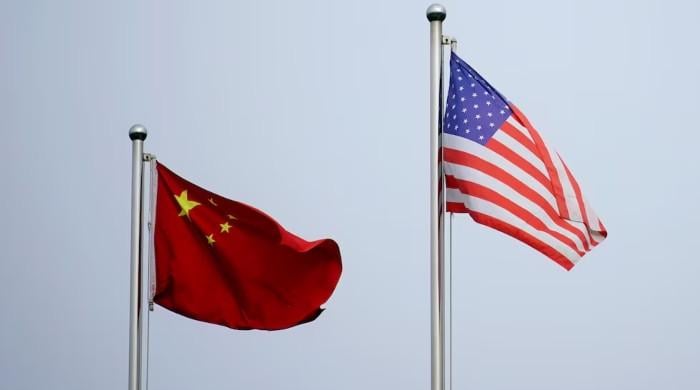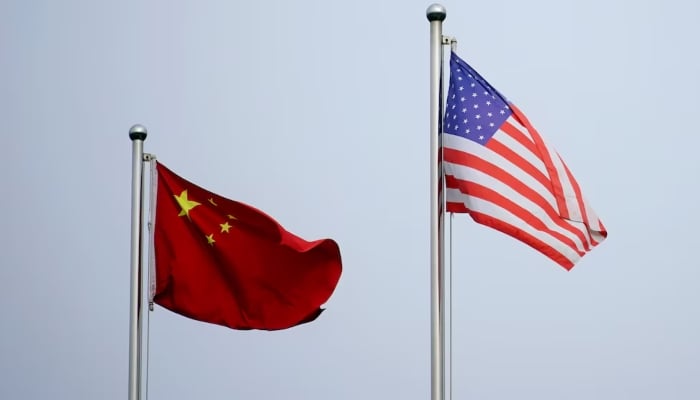Politics
US seeks to reboot military channels with China after Trump-Xi meet


- Hegseth meets Dong on Malaysia summit sidelines.
- Trump touts improved ties, tariff deal outline.
- Beijing urges policy-level dialogue to build trust.
US Defence Secretary Pete Hegseth said on Saturday that during talks with his Chinese counterpart, the two sides had agreed to reboot military-to-military links to “deconflict and deescalate”.
Hegseth met with China’s Defence Minister Dong Jun on the sidelines of a regional summit in Malaysia, a day after leaders Xi Jinping and Donald Trump held talks in South Korea.
“I just spoke to President Trump, and we agree — the relationship between the United States and China has never been better,” Hegseth said in a post on X, adding that he had spoken with Dong again since their face-to-face meeting.
“The Admiral and I agree that peace, stability, and good relations are the best path for our two great and strong countries,” he said, touting a path of “strength, mutual respect, and positive relations.”
The Pentagon chief said Dong and he “also agreed that we should set up military-to-military channels to deconflict and de-escalate any problems that arise.”
Such channels have existed for years but at times fallen out of use.
“We have more meetings on that coming soon,” Hegseth said without elaborating.
There was no immediate comment from Beijing.
According to a Chinese defence ministry readout of their meeting in Malaysia, Dong had told Hegseth the countries should “strengthen policy-level dialogue to enhance trust and dispel uncertainty”, and build a bilateral military relationship “characterised by equality, respect, peaceful coexistence and stable positive momentum.”
Last week, Trump said he had agreed to reduce tariffs on China to 47% in exchange for Beijing resuming US soybean purchases, keeping rare earths exports flowing and cracking down on the illicit trade of fentanyl.
His remarks came after face-to-face talks with Xi in the South Korean city of Busan, their first since 2019, marked the finale of Trump’s whirlwind Asia trip on which he also touted trade breakthroughs with South Korea, Japan and Southeast Asian nations.
Politics
Trump administration suspends US green card lottery


- Noem says suspect entered via DV1 in 2017.
- USCIS ordered to pause programme immediately.
- Lottery awards up to 55,000 visas annually.
WASHINGTON: US homeland security chief Kristi Noem suspended a green card lottery on Thursday, saying it was used by the suspect in a mass shooting at Brown University.
Claudio Neves Valente, a 48-year-old Portuguese national, is accused of bursting into a building at the Ivy League school on December 13 and opening fire on students sitting exams, killing two and wounding nine.
He is also accused of killing a professor at the Massachusetts Institute of Technology (MIT) two days later.
Noem wrote on social media that Neves Valente “entered the United States through the diversity lottery immigrant visa program (DV1) in 2017 and was granted a green card.”
“At President Trump’s direction, I am immediately directing USCIS (United States Citizenship and Immigration Services) to pause the DV1 program to ensure no more Americans are harmed by this disastrous program,” Noem wrote.
“This heinous individual should never have been allowed in our country.”
Neves Valente was found dead by suicide after a days-long manhunt, police said on Thursday evening.
The US green card lottery grants up to 55,000 permanent resident visas annually to people “from countries with low rates of immigration to the United States,” according to the State Department.
To qualify, applicants must have at least a high school education or two years of training or work experience.
They also go through a vetting process that includes an interview.
Trump administration also intends to increase its efforts to strip some naturalised Americans of their US citizenship, the New York Times reported on Wednesday, citing internal guidance.
The USCIS guidance, which was issued on Tuesday, asks its field offices to “supply Office of Immigration Litigation with 100-200 denaturalisation cases per month” in the upcoming 2026 fiscal year, according to the newspaper.
The guidance comes as Trump has spent much of this year closing loopholes in the immigration system and throwing up roadblocks for people seeking to enter and stay in the country.
US President Donald Trump has carried out an aggressive immigration agenda, including imposing travel bans and an attempt to end birthright citizenship since January.
His administration most recently paused immigration applications, including green card and US citizenship processing, filed by immigrants from 19 non-European countries.
— With additional input from Reuters
Politics
Australia’s Head slams unbeaten 142 to crush England’s Ashes hopes


Danger man Travis Head crunched his fourth century in as many Tests at Adelaide Oval Friday as Australia built a 356-run lead over England to stand on the brink of retaining the Ashes.
The hosts were 271-4 at stumps on day three of the third Test with Head on 142 and first-innings century-maker Alex Carey not out 52, taking the five-match series out of England’s reach.
England must win after crashing inside two days at the first Test in Perth and inside four in Brisbane, both by eight wickets.
But it appears to be an impossible task with the highest run chase at the ground 316 by Australia against England in 1902.
Head’s crucial ton, his 11th, came off a composed 146 balls although he almost didn’t get there, dropped on 99 by Harry Brook as impatience got the better of him.
He has now scored a century in four consecutive Tests on his home ground, following 140 against India last year and 119 and 175 against the West Indies.
Australia suffered an early setback in a tense 20 minutes before lunch after England were all out for 286 on the back of Ben Stokes’ gritty 83 in response to Australia’s first innings 371.
Bryson Carse trapped Jake Weatherald lbw for one and he walked without reviewing after the umpire lifted his finger, although replays showed the ball was pitching outside leg stump.
It gave England a glimmer of hope, but after the break Head slammed the door shut, cutting and chopping boundaries to all corners of the ground.
Marnus Labuschagne went for 13 when he edged Josh Tongue to Harry Brook at slip, with reviews showing it carried.
Usman Khawaja, who hit a defiant 82 in the first innings after his last-minute call-up for the ill Steve Smith, was a perfect foil for the more aggressive Head.
But on 40 he was undone by the spin of Will Jacks, caught behind, and Cameron Green followed soon after for seven, edging Tongue to Brook.
After getting through the nervous 90s, Head finally brought up his century with a four off Joe Root, taking off his helmet and kissing the turf before pumping his fists.
While not in the same vein as his match-winning 69-ball century in Perth, it was a critical knock, supported by Carey and aided by Stokes not bowling after his exploits with the bat.
Gutsy Stokes
After a woeful batting display on Thursday, Stokes and Jofra Archer kept England’s dreams alive with a stirring 106-run ninth-wicket stand.
They resumed at 213-8 in muggy conditions with Stokes not out 45 and Archer on 30.
Stokes, who suffered leg cramps and dehydration during his gutsy rearguard action in sweltering 40 Celsius heat on Thursday, brought up his slowest ever 50 in Tests, off 159 balls.
England’s Ben Stokes (L) and Jofra Archer run between the wickets on the third day of the third Ashes cricket Test match between Australia and England at the Adelaide Oval in Adelaide on December 19, 2025. — AFP
He kept plugging away but finally fell when Mitchell Starc took the new ball and bowled him, with Stokes one of the few players who showed the fight he had demanded before the game.
Archer was another, ably helping his captain.
The fast bowler was the last man out when caught by Labuschagne off Scott Boland for 51 — his highest Test score and a maiden half-century Boland ended with 3-45 while Pat Cummins took 3-69 in his first Test since July.
England’s woes began when openers Zak Crawley and Ben Duckett, along with the under-performing Ollie Pope, departed in a 15-ball blitz on Thursday at the hands of Cummins and Nathan Lyon.
Harry Brook showed some resistance with 45, but the Australian attack was relentless.
Politics
Saudi Arabia, Qatar have a white winter as snowfall hits northern areas


According to Khaleej Times, a period of low-pressure systems in the Middle East has brought heavy rainfall over the last week. Conditions were forecast to intensify on Thursday, with thunderstorms expected to hit the region.
The storm was then forecast to move eastwards towards the UAE and Qatar by night, it added, citing BBC Weather.
Khaleej Times reported that large areas of Qatar had also been covered by snowfall already, sharing a video of the landscape.
In Saudi Arabia, snow and light rainfall were experienced in Trojena, a mountain destination for hiking and skiing located on Jebel Al-Lawz in the province of Tabuk that reaches up to 2,600 metres, according to Arab News.
Additionally, light to moderate rain was experienced in Bir Bin Hermas, Al-Ayinah, Ammar, Al-Ula Governorate and Shaqra and its suburbs. Several other regions, including Riyadh, also experienced moderate to heavy rainfall, the outlet added.
Riyadh experienced thick cloud cover and rainfall from early yesterday. According to Arab News, all schools in the Saudi capital switched to remote learning amid the continuing inclement weather.
“The Qassim Region, including the city of Buraidah, experienced moderate to heavy rainfall, while Tabuk Region experienced light to moderate rainfall on Thursday,” it said, citing the Saudi Press Agency (SPA).
“Parts of Hail region also witnessed snowfall on Wednesday evening in areas surrounding the city of Hail, while light to moderate rainfall was reported across the region and several of its governorates.”
The outlet added that according to the SPA, the National Centre for Meteorology (NCM) anticipated more snow in the northern parts of the Riyadh region and the governorates of Al-Majmaah and Al-Ghat, north of Riyadh, which witnessed snowfall on Thursday morning that led to accumulations over highland and open areas.
The official spokesperson for the NCM, Hussein Al-Qahtani, explained that the weather conditions affecting the north of the region were caused by a cold mass of air advancing into the area, accompanied by rain-bearing clouds. This contributed to temperatures dropping below zero degrees Celsius in some locations.
“Al-Qahtani noted that the centre had issued early warnings regarding the weather conditions, adding that specialised teams continued to monitor developments,” Arab News said, adding that the spokesperson expected temperatures to remain low over the coming hours with a chance of frost in several northern and central areas.
He urged citizens and residents to exercise caution, particularly while driving on exposed roads, due to the potential formation of ice.
“He also stressed the importance of following official weather updates issued by the centre through its official channels, while adhering to preventive guidelines and avoiding open areas during peak cold periods to ensure public safety,” the agency said.
Reactions to unprecedented snowfall
Many people gathered to witness the snowfall in Al-Majmaah and Al-Ghat.
Thamr Alotaibi, a Riyadh resident, told Arab News, “This is unprecedented, so we are excited to see it. Me and my friends are going to experience this winter wonder which is going to be an amazing experience.”
Meanwhile, due to gusty and dust-stirring winds, the General Directorate of Civil Defence called for caution and adherence to guidelines in light of the inclement weather conditions.
“It has advised residents to avoid going to valleys during this spell of weather,” the outlet said.
Riyadh resident Abdul Hammed told Arab News: “We had an outing planned for a family get-together at a banquet on the city’s outskirts but the prevailing weather has forced us to change the plan, and we have decided to remain indoors instead.”
Experts say snowfall not unusual
Against this backdrop, a leading Saudi astronomer said such snowfall events are not unusual during the winter months, Gulf News reported.
Mohammed bin Reddah Al Thaqafi, an astronomer and expert at the Taif Astronomical Sundial and a member of the Arab Union for Space and Astronomy Sciences, said that snowfall in northern Saudi Arabia occurs periodically each winter, even though it does not follow a fixed astronomical cycle.
Its recurrence depends largely on shifting climatic and atmospheric conditions, he explained, according to the agency.
He added that snowfall was typically recorded between December and February and was most common in regions such as Tabuk, Al-Jouf and Arar, which are more exposed to Mediterranean weather systems than other parts of the kingdom.
“He identified areas including Jabal Al Lawz, Alaqan and Al Dhahr in Tabuk; Sakaka and Dumat Al Jandal in Al Jouf; Arar in the Northern Borders; Jabal Aja and Jabal Salma in Hail; and the highlands of Abha in Asir as the locations most likely to experience snowfall,” Gulf News said.
While some seasons pass without snow, the expert noted that these areas remain among the most reliable destinations for winter conditions, the agency added.
Al Thaqafi urged motorists and outdoor visitors to exercise caution in the snow, warning of slippery roads and reduced visibility, and stressed the importance of adhering to traffic regulations to avoid accidents, it said.
-

 Business6 days ago
Business6 days agoHitting The ‘High Notes’ In Ties: Nepal Set To Lift Ban On Indian Bills Above ₹100
-

 Politics1 week ago
Politics1 week agoTrump launches gold card programme for expedited visas with a $1m price tag
-

 Business1 week ago
Business1 week agoRivian turns to AI, autonomy to woo investors as EV sales stall
-

 Sports1 week ago
Sports1 week agoPolice detain Michigan head football coach Sherrone Moore after firing, salacious details emerge: report
-

 Fashion1 week ago
Fashion1 week agoTommy Hilfiger appoints Sergio Pérez as global menswear ambassador
-

 Business1 week ago
Business1 week agoCoca-Cola taps COO Henrique Braun to replace James Quincey as CEO in 2026
-

 Tech1 week ago
Tech1 week agoGoogle DeepMind partners with UK government to deliver AI | Computer Weekly
-

 Sports1 week ago
Sports1 week agoU.S. House passes bill to combat stadium drones






